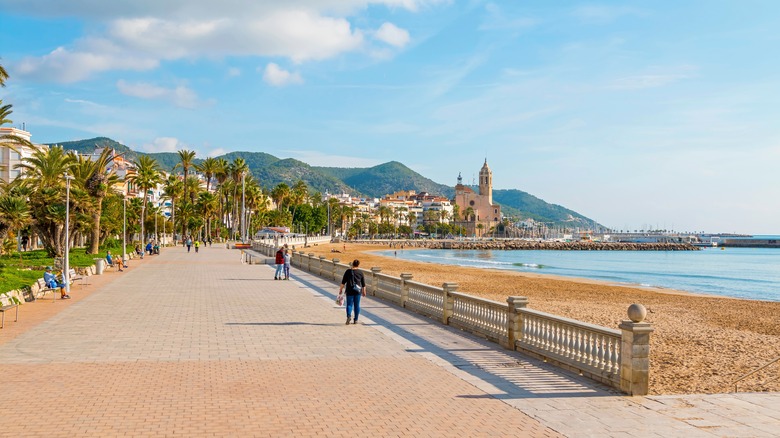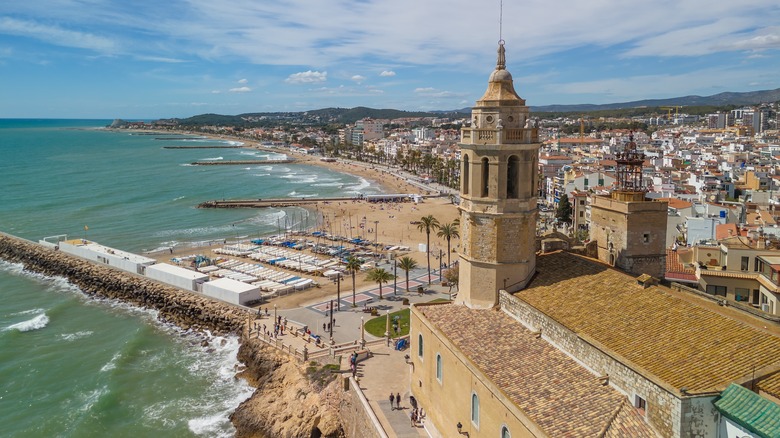The World's Happiest Beach Town Is A Paradise Along Spain's Scenic Coastline Just An Hour From Barcelona
Wind in your hand, toes in the sand — who doesn't love a day at the beach? But do some beaches make you happier than others? This question is what a new study conducted by CV Villas, a vacation rental booking platform based in London, aimed to find out. Compiling a list of 103 popular beaches around the world and thousands of photos gathered from social media, the company used AWS Rekognition software, an AI-powered tool, to analyze every image based on positive facial expressions, resulting in "an average smile score" for each beach.
There are many beautiful beaches that made it into the top 30 list, such as the Pacific Northwest's stunning Cannon Beach on the Oregon Coast, which represents the U.S. at #16, or even Dolphin Beach, a stretch of Caribbean Coast in Cancun which took home #12 for Mexico, but the #1 spot for happiest beach went to Sitges Beach, Spain, set in a charming beach town that is the perfect day-tripping distance from Barcelona.
Here's what you need to know about this happy — and historically gay, (as in literally LGBTQ-friendly) — beach town. It not only has smiley sands, but also is rich in art, culture, and history.
How to explore Sitges' happy beaches
If you're wondering what makes Sitges Beach so happy, let's start with size. Sitges has a whopping 19 beaches and approximately 10 miles of coastline from Cala Morsica to Playa del Muerto. On top of that, the city experiences about 300 sunny days per year, and it's a bustling town that regularly hosts major festivals like the Sitges International Fantastic Film Festival in the fall and the Gay Pride Parade in the late spring.
You'll find the main beaches downtown, just a short walk from the train station. Platja de la Ribera and Platja de la Fragata have fantastic views of the city's 14th-century church overlooking the sea. Keep walking north past the church to find the Vivero Beach Club between Platja de Sant Sebastià and Platja dels Balmins, but beware that the latter is clothing-optional and one of Sitges' famous "gay" beaches. For many decades, Sitges was a haven for LGBTQ+ travelers looking for a safe vacation destination where people could express themselves freely.
If you're struggling to find space to lay your towel on the main beaches, there is a long promenade you can walk down until you find a spot that suits you. If you want seclusion, keep walking past the golf course where you'll find trails to smaller rocky coves. These tend to be more quiet, but many, like Platja de l'Home Mort, are also clothing optional, so do some research so you know what you're getting into.
Beyond the beaches and how to get there
If you're already visiting and trying to avoid the crowds in Barcelona, Sitges is extremely easy and quick to get to by train. Leaving from the Sants Estació — this is the main train station, but you can get on at earlier stops if it's more convenient to your location — take the Rodalies R2 train south towards Vilanova i la Geltrú or St. Vicenç de Calders. Trains leave more than once per hour between 5 a.m. and midnight, and the journey takes about 30 minutes.
Even if it's not quite swimming weather, the old town streets and seafront promenade of Sitges are still worth seeing. In fact, a cloudy day is the perfect time to take advantage of the wonderful museums right on the waterfront. Sitges may not have any of architect Antoni Gaudí's modernist masterpieces, but it does have the collection of Santiago Rusiñol. The impressive assembly of modernist paintings, sculptures, furniture, and daily household items is on display at the Museu del Cau Ferrat, which is also connected to the art museum Museu de Maricel. There is also the Palau de Maricel, a gorgeous, early 20th-century building. It is only open for guided tours a few days per month, so check the website before your trip.


